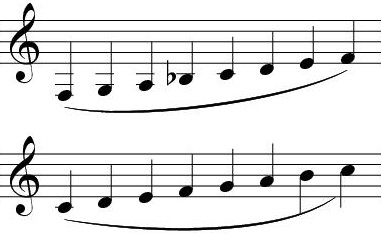- Home
- »
- Legato
Lié
Detache
Staccato
Sostenuto
Accents
Legato tonguing
Double tongue
Triple tongue
Cutting the sound
Slured
Legato is produced by the continuity and support of the breath between notes. There is therefore no articulation, nor any interruption of the sound or air between the notes.

The larger the intervals toward the higher register, the more air is required, and the more the sound will tend to increase in intensity. However, it is possible to control lip tension and air pressure to prevent the sound from becoming more intense.
Since legato uses more air than detache, playing very long legato phrases can be tiring. If the phrase is too long, it will inevitably need to be interrupted at some point to breathe. Loud dynamics and the low register require more air than soft dynamics and the high register. Consequently, it is difficult to sustain long and loud phrases in the low register without breathing (as with low brass instruments, it is sometimes necessary to breathe between each note).
Quickly chaining large slured intervals remains difficult. Unlike woodwind instruments, which have one fingering per note, brass players must “target” the correct harmonic. Most arpeggios, for example, are played with a single fingering for all the notes in the arpeggio. Hearing each note’s position internally when playing large slured intervals is not always easy at speed and requires intense concentration; this also increases the probability of missing notes.
